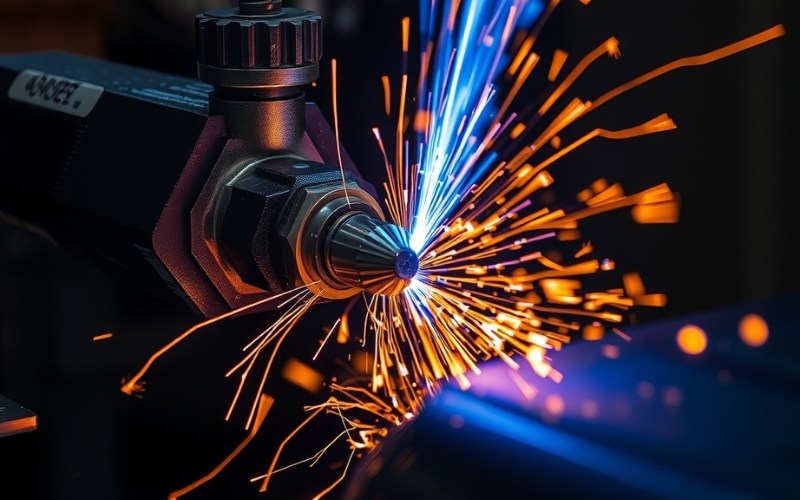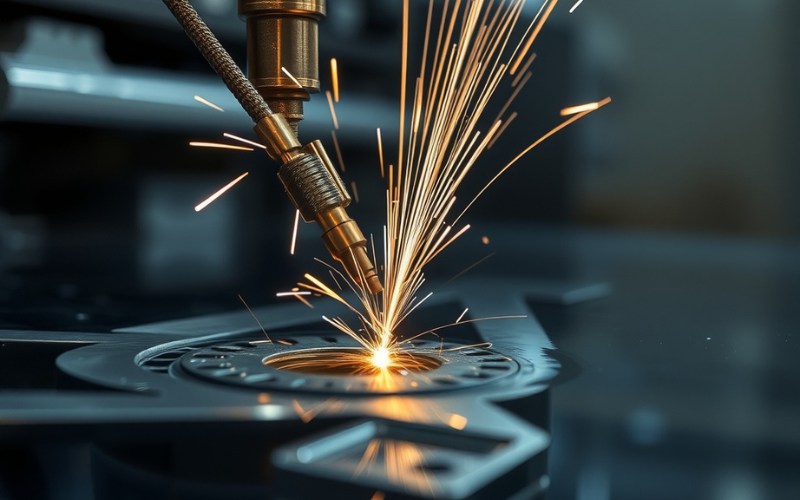Lasciate che Istar vi aiuti a iniziare il vostro progetto con la nostra esperienza e il nostro know-how!
Caricate i file del vostro progetto e i requisiti di produzione e vi risponderemo entro 30 minuti!

As someone with a lot of experience in precision machining, I’ve seen technologies appear and disappear. But one machining technique that has always impressed me with its accuracy and flexibility is Electrical Discharge Machining, or EDM. This is much more advanced than a standard drill press; we are talking about using electricity to shape metal, making detailed shapes that you couldn’t make with normal machining methods. If you make things for a living, especially from hard conductive materials, knowing about the different types of EDM machines isn’t just helpful—it’s necessary to keep up with the competition. This article will guide you through the three main types of EDM, showing you how they work, what they are used for, and how to pick the best one for what you need to make.
I recall the first time I watched an EDM machine working. It felt like I was seeing a magic show. There wasn’t a normal cutting tool, but a complicated shape was being cut from a hard steel block with no effort. The trick, I found out, is a process called spark erosion. Basically, every EDM machine, no matter the type of EDM, uses a quick series of electrical sparks to take away material from a workpiece. Think of it as a small, managed lightning storm flashing thousands of times every second.
The system uses two electrodes: one is the tool-electrode (the “cutter”) and the other is the workpiece-electrode (the part you are working on). They are placed in a dielectric fluid, a special liquid that doesn’t conduct electricity. When power is sent between the tool and the workpiece, the dielectric fluid can no longer insulate, and it creates a spark discharge. This spark makes a lot of heat, which melts and turns a tiny bit of material from the workpiece into gas. The moving dielectric fluid then washes away the waste. This happens over and over, thousands of times a second, slowly wearing away the workpiece to make the shape you want. The great thing about this machining technique is that the tool and the workpiece never touch. This removes all physical pressure and lets you work on very hard materials with very exact measurements. The fact that it doesn’t touch the part is what makes using EDM so groundbreaking.
Over my career, I’ve used many types of EDM machines. While they have their small differences, they all share some basic parts. Knowing these parts helps you understand how the whole EDM process operates. It’s like learning the parts of an engine before you try to fix it.
Here is a list of the key parts of an EDM machine:
| Componente | Funzione |
|---|---|
| Alimentazione | The core of the machine, it sends out the pulsed electrical power needed for the spark between the electrode and the workpiece. |
| Dielectric System | This has a tank, pump, and filter for the dielectric fluid. It moves the fluid around to insulate, cool the part, and wash away worn-out bits. |
| Electrode | This is the tool that makes the shape in the workpiece. For sinker EDM, it’s a shaped tool. For wire EDM, it’s a thin wire. The electrode’s material and shape are very important for a good result. |
| Workpiece and Fixturing | The workpiece is the material being cut. It must be able to conduct electricity. Fixtures are used to hold the workpiece tightly in place. |
| Servo Control System | This system keeps a very specific distance between the electrode and the workpiece. This is needed for a steady and effective EDM process. |
| Controllore CNC | Modern EDM machines are run by a Computer Numerical Control (CNC) system. This gives exact, automatic control over the machine’s movements, including on the x and y axes for wire EDM. |
When I started in this field, the most widespread type of EDM machine was the sinker EDM, also called ram EDM or conventional EDM. I have put in many hours setting up and using these reliable machines. The name “sinker” makes sense; a pre-made electrode is “sunk” into the workpiece to make a cavity that is a perfect reverse image of the electrode. This machining process is great for making complex 3D shapes, detailed cavities, and dies.
The electrode for sinker EDM is usually made from graphite or copper and is shaped into the negative form of the wanted cavity. The machine then pushes this electrode into the workpiece again and again while it sits in a dielectric fluid. Every time it pushes, electrical sparks wear away the workpiece material, making the complex end form. I have used sinker EDM for everything from injection molds to detailed tool parts. It’s a very useful tool for making features that are hard or not possible with regular machining, like sharp corners or blind holes. This type of EDM is also known as cavity-type EDM or volume EDM. The sinker discharge machining process is very flexible.

The arrival of the wire EDM machine was a huge step forward in my industry. This type of EDM machine uses a very thin metal wire that is fed continuously as an electrode to cut through a workpiece. The wire, which is often made of brass or a special coated material, is directed by diamond or sapphire guides and follows a path that is programmed with high accuracy. Picture a high-tech, electrically powered wire that can slice through any conductive material with amazing precision. This process is also called wire cutting or wire erosion.
The workpiece is placed in deionized water, which serves as the dielectric fluid. When the powered wire comes near the workpiece, a spark crosses the gap, wearing away a small bit of material. The CNC control lets the wire move along the x and y axes to make detailed 2D cuts. Fancier 5-axis wire EDM machines can also tilt the wire by moving the top and bottom guides on their own, which allows them to make complex sloped shapes. I have used wire EDM to make parts for everything from tiny medical devices to aerospace components that need to be extremely precise. The accuracy of a wire EDM machine is truly amazing; it can cut parts to within +/- 0.0001 inches. This machining technique, also called wire burning, is vital for today’s manufacturing. The wire EDM process is incredibly exact.
Sometimes, what seems like the easiest job can be the hardest. For example, drilling a tiny, deep hole in a very hard material. If you use a normal drill, the bit might move off course, break, or just not be strong enough. This is where hole drilling EDM, also known as EDM drilling, is useful. I’ve seen this special type of EDM machine as a very important tool in my workshop. It is made just for making small, deep holes that are much deeper than they are wide.
This edm method uses a spinning, tube-shaped electrode, usually made of brass or copper, to make the hole. A dielectric fluid is sent through the center of the hollow electrode to wash away the worn-out material. This constant washing is key to stopping short circuits and making sure the hole is clean and accurate. I have used EDM hole drilling to make starting holes for wire EDM, as well as cooling passages in turbine blades and fuel injector tips. The power of hole-drilling EDM to make holes as small as 0.065 mm wide and up to 1 meter deep is something that continues to surprise me. This precision machining process shows the real strength of EDM technology.
A common question I hear from new machinists is about the difference between elettroerosione a tuffo and wire EDM. Even though both are types of EDM machines that use spark erosion, what they are used for and what they can do are very different. You can think of it as the difference between a sculptor’s hammer and chisel and a fine-detail saw; both shape things, but in very different ways.
Here’s a table that lists the main differences I’ve seen through the years:
| Caratteristica | Elettroerosione ad affondamento (Ram EDM) | Elettroerosione a filo |
|---|---|---|
| Electrode | A solid electrode made into a custom shape. | A thin wire electrode that is fed from a spool. |
| Uso comune | Making 3D cavities, molds, and dies with complex shapes. | Cutting detailed 2D outlines, sharp corners, and sloped shapes. |
| Workpiece Shape | Can make blind cavities (holes that don’t go all the way through). | Can only cut through the full thickness of the workpiece. |
| Electrode Material | Usually graphite or copper. | Mostly brass or a coated wire. |
| Fluido dielettrico | Hydrocarbon oil. | Deionized water. |
Deciding between sinker discharge edm and a wire edm machine really depends on the specific shape of the part you have to make.
One of the biggest pluses of using an EDM machine is that it can handle a large variety of electrically conductive materials, no matter how hard they are. This has created many new opportunities in my work. Regular machining methods often have trouble with hard materials, but for an EDM machine, hardness isn’t an issue.
Here are some of the common conductive materials I have worked with using different types of EDM:
The main thing to remember is that the material must be able to conduct electricity. This thermal energy-based machining process won’t work on materials that don’t conduct electricity, like plastics or ceramics, without using special methods.
I have a lot of respect for standard machining methods like CNC machining, but there are situations where an EDM machine is just the superior tool for the task. Through my experience, I’ve seen several cases where EDM provides clear benefits over regular machining.
Here are some of the main advantages of using EDM that I’ve seen for myself:
Of course, the machining process can be slower than standard methods, but for the correct job, the pluses of using an EDM machine are easy to see.

From what I’ve seen, the electrode is one of the most important parts of any EDM machine. Its shape, material, and quality all have a big impact on the final accuracy and speed of the machining process. The job of the electrode is to carry the electrical current and create the spark that wears away the workpiece.
In elettroerosione a tuffo, the electrode is a custom tool that is the opposite shape of the cavity you want to make. The choice of electrode material, like graphite or copper, is based on things like how fast you want to remove material and the kind of surface quality you need. I’ve discovered that a well-made electrode is the secret to getting a high-quality part.
In elettroerosione a filo, the electrode is a thin wire that moves continuously. This wire electrode is what makes it possible to create such detailed and exact cuts. The constant supply of new wire means the cutting edge is always fresh and avoids the problem of tool wear that happens in regular machining. This use of a wire as an electrode is a key part of this type of EDM. The EDM electrodes are essential to the process.